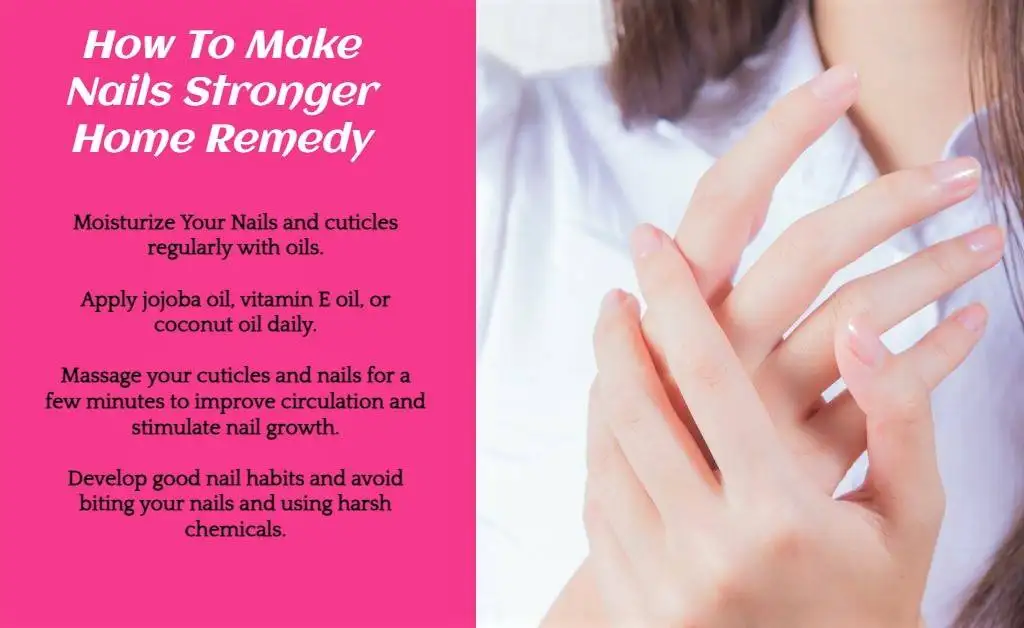In recent years, dip powder nails, also known as dip nail manicures, have seen a significant rise in demand as a nail service. Dip powder nails are a popular choice for those who want a long-lasting, chip-resistant manicure with a variety of colors to choose from. They are less harmful to the natural nails than acrylics, as they do not require as much filing or drilling. However, they still involve some chemicals and exposure to UV light, which can weaken the nails over time.

Some of the pros and cons of dip powder nails are:
Pros:
- They are durable and resistant to chipping, cracking, and peeling for up to three weeks.
- They come in a wide range of colors and finishes, from matte to glittery.
- They are easier and faster to apply than acrylics, as they do not require sculpting or curing under a UV lamp.
- They are less damaging to the natural nails than acrylics, as they do not involve as much filing or drilling.
Cons:
- They can be expensive, ranging from $35 to $60 per service.
- They can be difficult to remove, requiring soaking in acetone for 10 to 15 minutes and scraping off the powder.
- They can weaken the natural nails over time, especially if they are not applied or removed properly.
- They can cause allergic reactions, infections, or nail fungus in some people, especially if the salon does not follow proper hygiene and safety protocols.
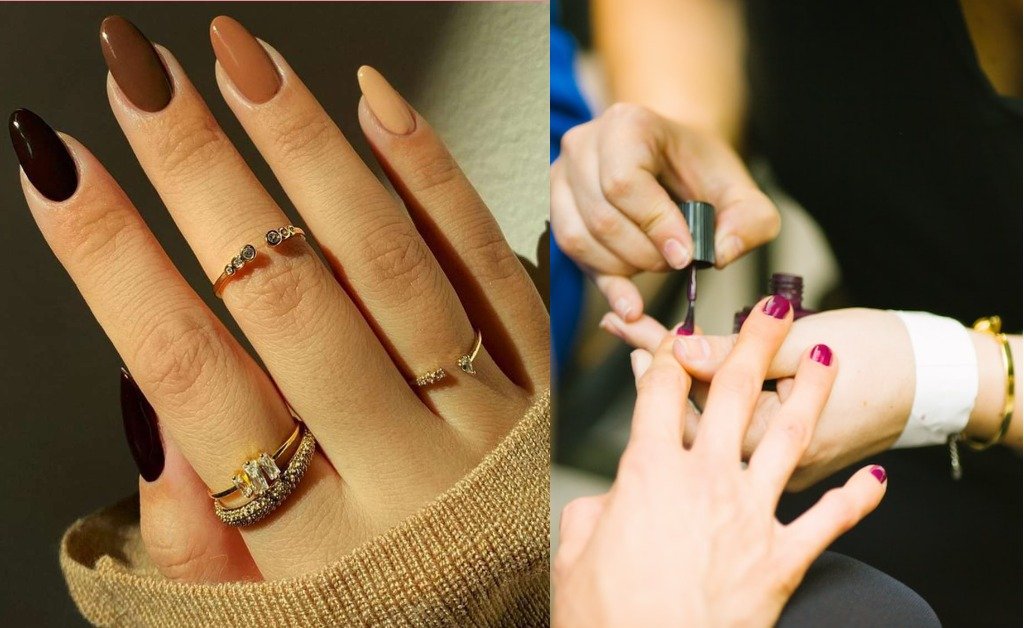
Pros and Cons of Dip Nails Detailed View
Dip nails have some advantages compared to other nail treatments. Dip Nails provide long-lasting results, generally lasting 2-3 weeks without breaking. The dip method can also allow you to reach salon-quality nails at home without LED lights.
Removing dip manicures, however, is a tedious process. Soaking nails in acetone is required to dissolve the bond between the powder and nail, which can take 30 minutes or more. Dip manicures also tend to be on the pricier side, with initial kits costing $50-80 and refill powders around $10-15 as needed. The multi-step removal offsets the otherwise convenient at-home application.
Pros of Dip Nails
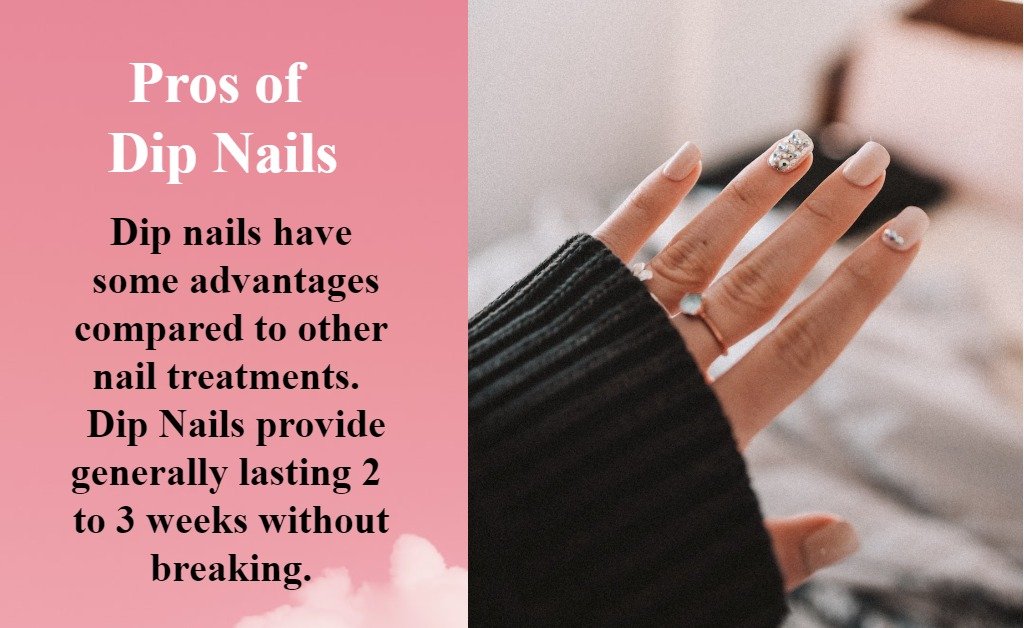
Durability
One of the biggest advantages of a dip powder manicure is its durability. The dip powder is bonded to the natural nail using a resin or glue, creating what is an acrylic nail overlay on your natural nail. This makes dip nails much stronger and longer-lasting than a traditional polish manicure. Most people can go 2-3 weeks without chipping or lifting when getting dip powder nails. For those who find regular polish chips within a few days, dip nails are a great option for stronger nails that don’t need to be touched up as frequently.
Low Maintenance
The acrylic-like finish of dip powder nails means you don’t have to worry about your manicure once you leave the salon. There is no need for regular touch-ups or reapplications as there is with traditional nail polish. The reinforced finish protects the nails from chips, cracks, and smudges. You can go about your daily activities without worrying about ruining your manicure. This makes dip powder a convenient, low-maintenance option.
Dries Quickly
Unlike gel polish or traditional acrylic nails, dip powder does not require time under a special lamp or light to cure or dry. Instead, each layer of dip powder is sealed onto the nails using an activator spray. This means you can walk out of the salon with completely dry, ready-to-go nails in a fraction of the time it takes for a gel manicure. The quick turnaround time is a major perk for many busy clients.
Natural Look
While acrylics often have an artificial look, dip powder nails provide a more natural finish. The powder comes in clear options and a wide variety of natural nude and sheer pink shades. This allows clients to get the stronger durability of acrylics while still having a polished, yet natural, nail look. Compared to acrylics or gel polish, dip nails tend to have a thinner, more subtle profile on the nail.
Many Color and Design Options
Dip powders come in a huge variety of colors, finishes, and effects. Whether you want a solid color, French tips, or an embellished nail art design, it can be achieved with dip powder. The dipping process allows for unlimited creativity when it comes to colors and designs. You can easily change up your color from fill to fill for variety. Glitters, foils, and chrome effects can be incorporated for very on-trend dip powder manicures.
Better for Nails than Acrylics
Unlike acrylic nails, dip powder does not require any heavy filing down of the natural nail. Dip powder is applied over the natural nail surface, making it gentler on the nails. Acrylic application and removal can thin and weaken the nails over time, while dip powders do not damage the nails in the same way. This makes dip powder a better option for maintaining healthy natural nails long-term.
Cons of Dip Nails
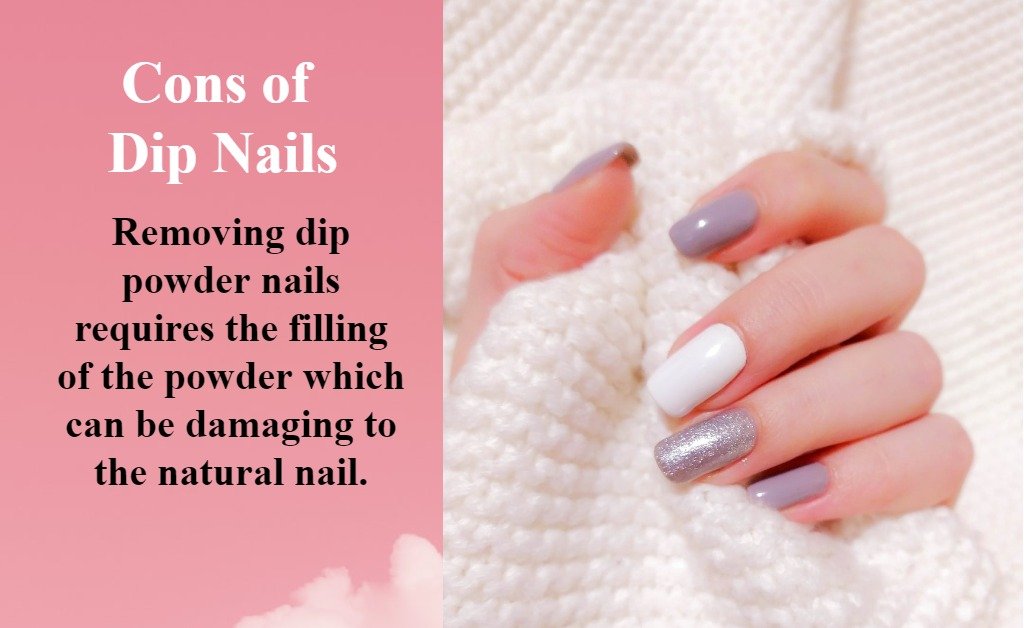
Lifting Issues
While a good dip manicure should last 2-3 weeks on average, they are prone to lifting around the tips and edges, especially as the nails grow out. This can lead to an unsightly appearance, with gaps between the powders and natural nails. If the powders are not applied properly and bonded correctly to the nail, the manicure is more likely to lift and gap. Keeping up with fill appointments can help prevent lifting.
filing/Buffing of Nails
To prepare the nails for dip powder application, the natural nails must be filed and buffed to create a rough surface for the powder to adhere to. This filling can thin out the nails over time with repeated dip powder manicures. It’s important to take breaks in between dip powder applications to allow the natural nails to grow out and strengthen.
Removal Process
Removing dip powder nails requires the filling of the powder, which can be damaging to the natural nail. Harsh filing and picking can thin the nails. Acetone cannot penetrate the powder, so soak-off removal as with gel polish is not an option. The manual filing of dip powder should be done carefully by a professional to avoid excessive thinning of the nail plate.
Can Feel Thick or Heavy
Some people dislike the feeling of having a thicker layer of product built up on their natural nails. While dip powder tends to be thinner than acrylics, it can still feel heavy and noticeable on the nails for some. This is especially true as the manicure grows out. The thickness is unavoidable and can take some getting used to for those not familiar with enhancements.
Higher Cost
Dip powder manicures typically cost $30-$50 for a full set and $25-$40 for fills every 2-3 weeks. While the manicure may last up to 3 weeks, the cost for regular fills makes it a higher maintenance service than traditional polish. The cost can add up over time, making it less accessible and affordable than simple Polish applications.
Can’t Do Nails at Home
For those who like doing their nails at home, dip powder is not an option. The entire dipping process requires professional supplies and tools. While regular polish can be purchased for home use, the powder and liquids used for dip powder nails are sold for salon use only. Clients must go to a salon each time to maintain the manicure.
Time Commitment
Between the long appointment time for the initial full set application and the regular fills needed every few weeks, dip nails require a substantial time commitment. Weekly or bi-weekly salon visits may not fit every client’s lifestyle and schedule. Especially for quick touch-ups or color changes, dip powder is much more time-consuming than painting on traditional polish at home.
Not Environmentally Friendly
The process of applying and removing dip powder nails generates a lot of dust and waste. Large amounts of paper and plastic materials are used during application. Swirling the nails in layers of fine powder creates airborne dust. Additionally, files and buffers must be discarded after each use. While most salons take precautions to minimize and contain dust, it is inevitable. Dip powder nail service is quite wasteful compared to more eco-friendly polish options.
Side Effects of Dip Powder Nails
While dip powder manicures are generally considered safe nail enhancements, there are some side effects to be aware of:
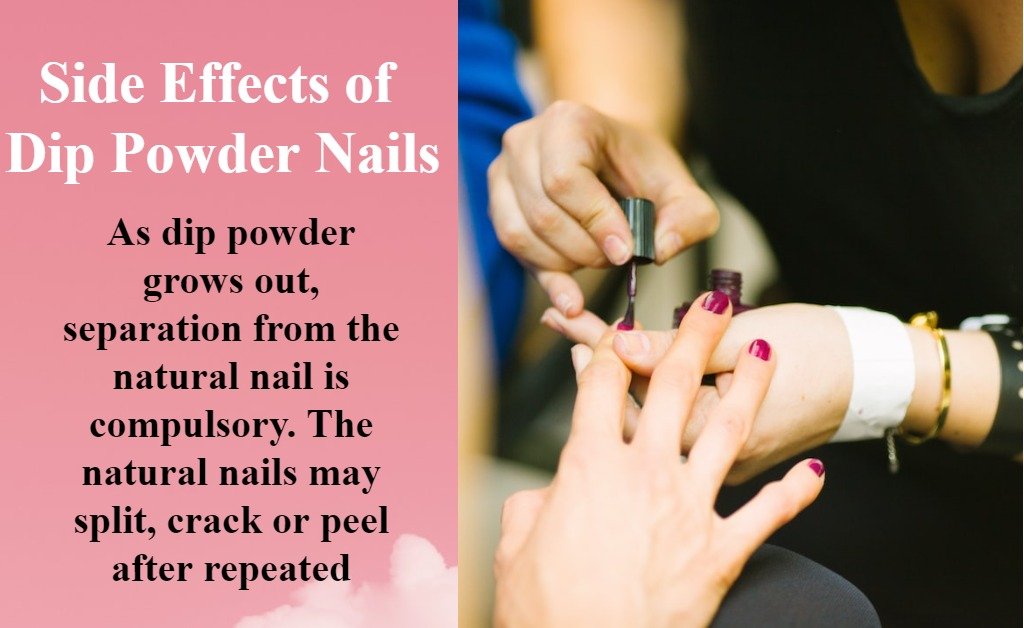
Skin or Nail Irritation
The glues, resins, and activators used to bond layers of dip powder contain chemicals that can cause skin or nail irritation in some people. Signs of irritation include redness, itching, burning, stinging, or swelling around the nail and cuticles.
Allergic Reactions
In rare cases, certain chemicals like methacrylates in dip liquids may trigger an allergic reaction in sensitive individuals. Reactions can appear as rashes, hives, blisters, or trouble breathing.
Lifting
As dip powder grows out, lifting and separation from the natural nail is common. Bacteria and fungi can grow in these lifted areas leading to infections. Keeping nails clean and dry while monitoring for lifting reduces infection risks.
Thinning Nails
While dip powders are less damaging than acrylics, repeated filing of the natural nails during fills can cause thinning and weakening over time. Taking breaks between powders allows nails to strengthen.
Discolored Nails
Color staining may occur from darker-pigmented powders, especially reds. Yellowing underneath the powder can happen from adhesive seeping into the nails. Whitening products can help reverse some discoloration.
Broken or Peeling Nails
If not applied and removed properly, dip powders can leave nails feeling brittle and damaged. The natural nails may split, crack or peel after repeated powder use. Moisturizing and taking breaks allow nail health to recover.
Does Dip Powder Strengthen Nails?
There are conflicting opinions on whether dip powder strengthens natural nails. The powder alone does not strengthen nails. It essentially creates an acrylic overlay that covers and protects the nail. So in this sense, dip powders do not inherently strengthen the nail structure itself.
However, dip powder can reinforce weak, brittle nails prone to splitting and breaking by acting as an artificial shield. The durability of the powder makes nails less likely to bend and snap. Frequent dip powder use can lead to thinning of the natural nails over time with repeated filing. This thinning effect weakens nails long-term.
- If done properly with careful, minimal filing dip powders should not damage the nails. The overlay can temporarily reinforce nails, allowing them to grow out stronger underneath.
- Taking occasional breaks from powders allows the natural nails to rehydrate and strengthen on their own. Alternating with powders and breaks is ideal for nail health.
- Certain nail-strengthening base coats or treatments can be used along with powders to reduce natural nail damage from filing. This maximizes strengthening benefits.
- Well-applied and properly maintained dip powders can reinforce weak nails in the short term while supporting natural nail growth. Taking precautions prevents excessive damage from filing.
Why Do My Nails Hurt After Dip Powder?
It’s common to experience some nail soreness or sensitivity after getting a dip powder manicure. There are a few reasons this may happen:
- Filing/Buffing – The process of filing down the natural nails before powder application can cause nail discomfort. Thinning the nails and exposing fresh layers makes them feel raw and tender.
- The heat from Filing – The friction of filing generates heat on the nails, which can burn or sting the nail beds. This is especially true if too much filing is done.
- Chemical Irritation – Glues, primers, and activators used can contain chemicals that irritate nails and make them feel sensitive after application. Acids in activators can burn if over-applied near cuticles.
- Improper Application – When powders are not applied correctly, bumps or areas of unevenness press into the nail, causing pain. The proper technique ensures an even, comfortable application.
- Damage two Nails – Cracks, lifting, and other damage from improper dip powder removal can make nails feel sore. Filing must be done with care to avoid thinning or injuring the nails.
The discomfort is usually temporary as nails recover and adjust to the powders within a day or two. Persistent pain could signal improper application and damage, indicating a need for removal and nail repair.
Advantages/
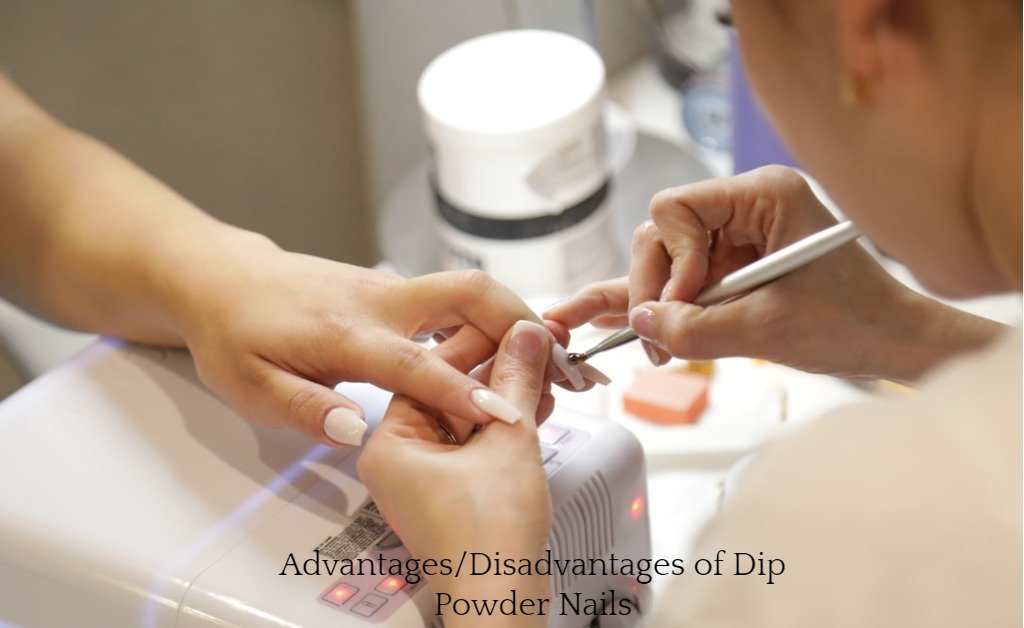
Advantages of Dip Powder Nails
- Durability – Powders last 2-3 weeks between fills without chipping or cracking. Reinforces weak natural nails prone to splits.
- Low maintenance – No need for regular touch-ups compared with traditional polish. The manicure lasts with everyday wear and tear.
- Quick drying time – No UV light required. The manicure is dry and ready to go after the spraying activator.
- Natural looking – Sheer color options and thin application create a subtle, natural nail appearance.
- Endless design options – Huge variety of powder colors and the ability to get creative with nail art.
- Less damaging than acrylics – does not require heavy filing of natural nails.
Disadvantages of Dip Powder Nails
- Lifting – Tendency to lift from the nail plate as it grows out. Can harbor bacteria and fungus.
- Frequent fills – must go every 2-3 weeks for fill appointments to prevent lifting.
- Filing required – Some filing of natural nails is needed with each fill leading to thinning over time.
- Removal process – No soaking off. Must be manually filed off which can damage nails.
- The feeling of thickness – Layers of powder can feel heavy and noticeable on nails for some.
- Higher cost – Fills every 2-3 weeks is a higher maintenance service than regular polish.
- Cannot do at home – Requires purchasing professional dip system. It cannot be DIY.
- Time commitment – Regular salon visits for fills. Time-consuming compared to painting nails.
- Not eco-friendly – Dusty applications and disposable supplies create a lot of waste.
Nails Reel Tight After Dip
It’s not unusual for nails to feel tight, tingly, or pressured after a dip powder application. Here’s why:
- Adhesives Contracting – Glues and resins shrink and contract slightly as they dry and set on the nails. This can create a pinching, tight sensation.
- Circulation Changes – Thicker powder layer disrupts normal nail circulation and pressure points, causing a tightness feeling.
- Improper Fitting – If powders are applied unevenly or sized too small, the nails will feel squeezed and uncomfortable.
- Chemical Interactions – Certain primers or adhesives may react with natural nail chemistry and cause irritation or tightness for some people.
- Natural Nail Damage – Existing nail conditions like fungus or trauma can make nails feel tighter with any enhancement application.
- Getting Used To Product – For those new to enhancements, the feeling of product on nails takes an adjustment period to get comfortable.
In most cases, nail tightness dissipates within a couple of days as clients adjust to the feel of dip powders. Persistent tightness or pain could indicate a poor application and may require removal to prevent nail damage. Keeping the nails properly shaped, sized, and filed helps minimize discomfort.
Conclusion
Dip powder nails can be a great option for many people, as long as they are done by a professional nail technician who follows proper hygiene and safety protocols. By considering the pros and cons of dip powder nails, one can make an informed decision about whether they are suitable for their nail needs and preferences. Therefore, it is advisable to take breaks from dip powders every few months and use nail strengtheners and moisturizers to keep the nails healthy.
FAQs
Why do my nails hurt after dip powder?
Filing the natural nails, friction heat from filing, chemical irritation from primers/glues, improper application causing unevenness, and existing nail damage can all cause soreness or pain after dip powder application. It’s usually temporary but may signal improper technique if persistent.
How often should you take a break from dip nails?
Nail experts recommend taking a break from dip powders every 2-3 months. This allows the natural nails time to strengthen and recover from repeated filing. Breaks prevent excessive thinning of nails.
What is the healthiest nail option?
Polished natural nails are considered the healthiest option, as they allow nails to breathe and don’t require removal filing. If enhancements are desired, dip or gel powders/polishes are less damaging options than acrylics when done properly.
Does dip powder weaken your nails?
Over time, repeated thinning from filing natural nails during fills can weaken nails. Taking regular breaks allows nails to regrow stronger. Using strengthening base coats and carefully removing powders prevents excessive weakening.
Why are my dip nails chipping after one day?
Chipping immediately after application means the powder was not properly adhered to the nail. Oily nail beds, not enough activator sprays, or skimping on powder layers can prevent proper bonding and lead to early chipping.
What are the least damaging fake nails?
Gel polish or dip powder nails are the least damaging options. With careful, minimal filing and removal, gel, and dip can reinforce nails without excessive thinning seen with long-term acrylic use.
How do you maintain dip nails?
Get fills every 2-3 weeks to prevent lifting or excessive growth. Use cuticle oil daily to hydrate nails and cuticles. File free edges carefully at home, avoiding over-filing. Protect hands from chemicals, and gloves for cleaning.
Why do my dip nails lift so quickly?
Frequent lifting likely means improper application – nails not buffed enough, activator not sprayed adequately, or adhesive bond isn’t strong. Could also signal natural oils interfering with bonds. Nails may need more prep.
How do you restore your nails after dip powder?
Apply nail treatments with strengtheners like biotin or calcium. Use cuticle oils/creams regularly to hydrate. File away the remaining residue carefully. Get regular trims and polish to allow nail renewal.
Can you dip really short nails?
Yes, dip powder can be done on very short natural nails. The powder overlay adds strength and protection to fragile short nails. The expert application ensures a smooth finish that adheres well even on bitten or stubby nails.
Discover more from Beauty Fashion Palace
Subscribe to get the latest posts sent to your email.


